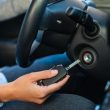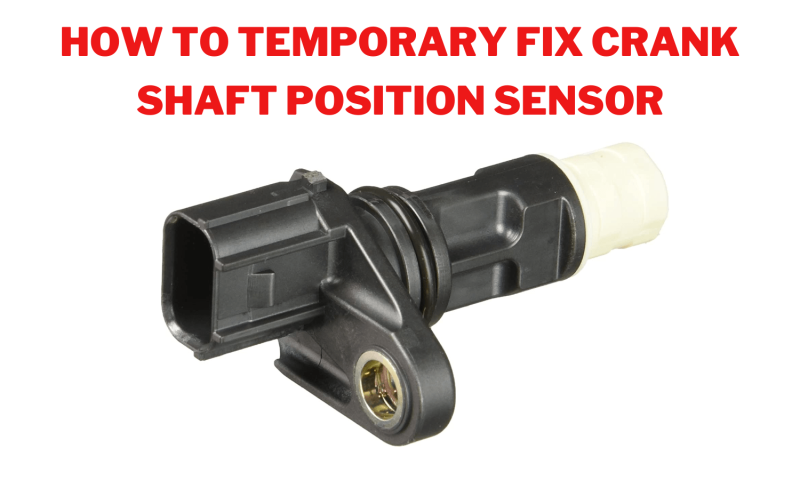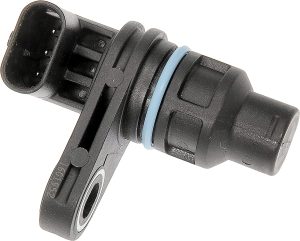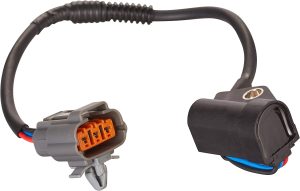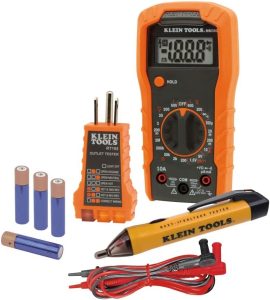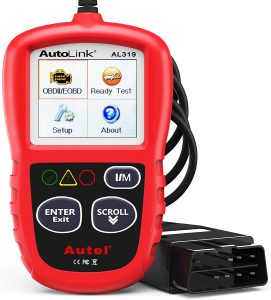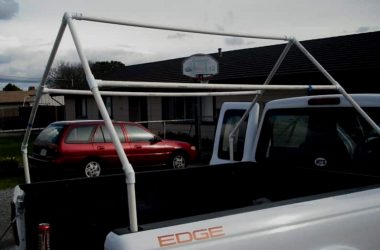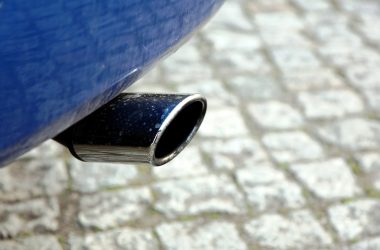Cars are an integral part of our fast-paced life in this modern age. Our vehicles and way of living are modernizing with time. In this modern era, we use vehicles full of modern devices and sensors to make our journey safer and more comfortable.In this article, we’ll discuss the ins and outs of crankshaft position sensors and uncover what makes them so essential.
The crankshaft position sensor plays a paramount role in any internal combustion engine – it monitors the speed and positioning of the crankshaft to guarantee more exact fuel injection timing as well as several other essential engine operations. It reads a signal received from the magnetic core when it moves through various magnets attached to the crankshaft, providing an accurate reading every time.
This sensor can cause some major issues with your vehicle’s functioning, from misfiring to stalling and possibly even breaking down completely in the most severe circumstances. Many people get their vehicle to a mechanic if they find out that the crankshaft position sensor gets faulty. Fortunately, some temporary fixes keep your car running until you reach a repair shop.
In this article, we’ll discuss temporary fix for crankshaft position sensor that may help resolve a crankshaft position sensor issue while you wait for permanent repairs. Furthermore, we’ll explain how to pinpoint when the sensor is faulty and outline what must be done once it’s time for a substitution. But remember that temporary fixes for crankshaft position sensors do not always work.
Table of Contents
What Does the Crankshaft Position Sensor Do
The crankshaft position sensor is responsible for several key engine functions. It sends signals to the vehicle’s computer system, providing important information about the crankshaft’s rotation and other engine components. This helps determine when the ideal time for fuel injection is, as well as helps control spark timing and other essential engine elements. Malfunctioning of this component can result in a grave fall-off in the performance level of your vehicle.
Buy on Amazon
How Does the crankshaft sensor work
The crankshaft position sensor is a type of magnetic induction sensor. It works by measuring the signal from a magnetic core as it passes through magnets attached to the crankshaft. And the signal depends on the rotation of the crankshaft, which generates data based on rotation that is used to control multiple components in the engine.
The position sensor will detect any irregularities with the fuel injection timing and send a signal to the ECU, allowing it to make necessary adjustments. Additionally, when there’s an issue with spark timing or other important engine functions, this can be determined through signals from the crankshaft position sensor. This helps ensure that your vehicle runs optimally and efficiently and helps prevent any costly breakdowns.
Furthermore, current crankshaft position sensors not only observe the rotation of the crankshaft but also can identify knocks, misfires and several other engine malfunctions. A crankshaft position sensor helps identify potential problems quickly and address them before they cause further damage or lead to a breakdown.
Consequently, the crankshaft position sensor must be in good working order. If this component is defective, it can have serious consequences on your car’s performance. It could cause breakdowns if neglected and left unresolved. By following a few simple steps, you can keep your car running efficiently until your reach an auto shop.
Buy On Amazon
Symptoms of a Faulty Crankshaft positions Sensor
If your vehicle is exhibiting difficulty when starting, it could be a sign of an impaired crankshaft position sensor. Other symptoms can include sluggish acceleration, reduced fuel efficiency, misfiring or engine stalling, and low performance. If the issue persists, take your car to a qualified technician who can diagnose and replace the crankshaft position sensor. Ignoring these symptoms can lead to further damage to the engine.
Check Engine Light
Another symptom of a faulty crankshaft position sensor is the activation of the Check Engine Light. This light usually indicates an issue with the engine or related parts and can be caused by a faulty crankshaft position sensor. If your car’s Check Engine Light appears on your dashboard, consult to a professional as soon as possible. A professional automotive technician can properly diagnose and repair any issues relating to the crankshaft position sensor.
Hard To acceleration
If you notice sluggish acceleration or lack of power in your vehicle, it could indicate a faulty crankshaft position sensor. A healthy crankshaft position sensor feeds the engine with the correct amount of fuel and air required to produce power. When it fails, the lack of fuel and air can result in your car’s inability to accelerate correctly. This can be dangerous while driving as acceleration is an essential element in maintaining control over your vehicle.
Engine Stop Suddenly
A faulty crankshaft position sensor may cause the engine to stop instantly while running. This can even occur when the car is idle. The engine will die immediately, and the check engine light will come on.
Loss of Power
Another symptom of a malfunctioning crankshaft position sensor is a noticeable decrease in power output from the engine. This can be caused by an inconsistency in fuel delivery or spark timing, both of which are controlled by the CPS.
Engine Misfiring
When the crankshaft position sensor malfunctions, it can cause misfiring within the cylinders. Which leads to jerky acceleration and poor performance from the engine, as well as an increase in fuel consumption.
Unable to start the car
If a car cannot start with sufficient fuel and spark, it could be due to a faulty crankshaft position sensor. This part helps the engine determine where the piston position and ignition timing should be for optimum performance. When this sensor fails, the computer will not get the signal it needs to start the engine.
Performance Issue
Finally, a faulty crankshaft position sensor can lead to decreased performance in your vehicle. If the sensor is unable to deliver precise measurements to the engine, it can cause a decrease in performance and you face a bad driving experience. Sometimes, you may experience jerking or hesitation while driving, which could be related to a failing crankshaft position sensor.
Reduced Fuel Efficiency
A faulty crankshaft position sensor can also reduce fuel efficiency because it cannot provide the engine with accurate readings. This can lead to a flawed mixture of fuel and air entering the engine, causing an excess of unburnt fuel to be discharged through the exhaust system. If you start to notice a decrease in fuel efficiency, take your car to a professional?
Also Read: How to Check Car leaking Oil When Parked
How to temporarily fix Crankshaft Position Sensor
Restart Engine
You can start by restarting your engine. The simplest way to complete this task is by starting your vehicle and then quickly turning it off. It can help reset the sensor and eliminate any misfiring or other complications caused by a faulty crankshaft position sensor. This trick works sometimes.
Check Wiring
Next, ensure that all the wiring connected to the crank position sensor is in good condition. Check for any frayed wires, loose connections, or cuts in the wiring harness. If you spot any issues like these, they may be causing your crankshaft position sensor problems.
Clean Connectors
Clean all of the connectors on the crankshaft position sensor with an electrical contact cleaner. Removing any dirt, grease, or corrosion will also help that may have built up on the connectors. Cleaning can also resolve the problem if it’s due to dirt or corrosion.
Filling up fuel
Make sure that the fuel tank is full. A lack of fuel can cause a faulty crankshaft position sensor, and having enough gas in the tank will help get it back up and running. The sensor can throw no fuel signals to the vehicle computer, which can cause a problem like sudden Stop and not starting.
Disconnect Crankshaft Position Sensor
Disconnect the crankshaft position sensor from its wiring harness and then reconnect it which is useful sometimes. Disconnecting and reconnecting will help reset the sensor and hopefully fix any misfiring or other issues related to a faulty crankshaft position sensor.
These simple fixes can help your crankshaft position sensor work properly in the short term. If you are still having problems with your crankshaft position sensor, it is essential that you replace it immediately. If you ignore a bad crankshaft sensor, you can face severe damage or lose your vehicle engine entirely.
How to test Bad Crankshaft Position Sensor
You will need a multimeter, replacement parts, and an appropriate code reader to test the crankshaft position sensor. Start by disconnecting the negative battery cable and locating the crankshaft position sensor. Disconnect the electrical connector, examine it for signs of corrosion or damage, and inspect the wiring for any wear. If there are any signs of corrosion, replace the connector and wiring. Once this is done, you can start testing the signal from the crankshaft position sensor.
Using a multimeter
You can use a multimeter to measure resistance and connect it to the two terminals on the sensor’s electrical connector. The reading should be within a certain range depending on the type of crankshaft position sensor you have. If the reading isn’t within that range, it’s likely that the crankshaft position sensor is defective and should be replaced.
Buy On Amazon
Using OBD II Scanner
If the multimeter tests prove inconclusive, you can also use an OBD II scanner to test the crankshaft position sensor. Connect the scanner to the vehicle’s onboard diagnostic port and start up the engine. The scanner will display any codes related to problems with the crankshaft position sensor and provide live data from various sensors on your vehicle. OBD scanner information is used to pinpoint and diagnose any issues more accurately.
Buy on Amazon
Also Read: How to Fix Charging Port in Car
FAQ’S
Can I replace the crankshaft sensor myself?
The short answer is yes, you can replace a crankshaft sensor yourself. However, it’s not necessarily an easy job and requires some knowledge of car mechanics. It’s essential to read up on the exact procedure for your vehicle before attempting to do so.
In general, replacing a crankshaft sensor involves draining the engine’s oil and removing components such as spark plugs and other bolts to access the sensor. After that, disconnect any wiring connected to the sensor and remove it entirely before installing its replacement. Once installed, you must reassemble all components in reverse order and refill the oil. If done correctly, this should have your engine running smoothly once again.
What happens if I drive my vehicle with a bad crankshaft sensor?
The crankshaft sensor is responsible for monitoring the engine’s speed and position, so if it fails, the vehicle cannot detect when or how much fuel needs to be injected into the engine. This can cause your car to idle rough or misfire, especially under load. It may also cause a loss of power or stall during acceleration or deceleration.
Additionally, the Malfunction Indicator Lamp (MIL) may be triggered to alert you of a potential issue with the crankshaft sensor. Diagnosing and repairing this issue as soon as possible is important, as it can lead to further engine damage if left unchecked.
What damages crankshaft position sensors?
A number of factors, including engine heat or oil sludge buildup, can damage crankshaft sensors. They may also be damaged due to wear and tear over time. Other causes could include physical damage from contact with other components in the engine, contamination from dirt and debris, or a malfunctioning wiring harness.
Additionally, certain types of crankshaft sensors may become corroded due to exposure to water or extreme weather conditions. If you want to protect your vehicle’s crankshaft position from damage, following your vehicle’s maintenance schedule, as the manufacturer recommends, is important.
Regularly checking the wiring connections and inspecting the area around the sensor for signs of wear should also help protect it from potential damage. If you experience any issues with your crankshaft sensor, it is important to take your vehicle in for service as soon as possible to prevent costly repairs down the line.
How to start a vehicle with a bad crankshaft sensor?
If you suspect that your crankshaft sensor is causing the issue, there are some steps you can take to try to start your car with a bad crankshaft sensor. Firstly, check all of the fuses in the engine compartment and replace any that are blown.
If this doesn’t solve the problem, you can temporarily bypass the crankshaft sensor by connecting a wire directly between the positive and negative terminals of the battery. Bypassing will allow direct current to flow to the ignition system, which should start the vehicle. However, running your car this way is recommended for only a short time.
How much it cost to replace the crankshaft sensor?
The cost of replacing a crankshaft sensor varies depending on the make and model of your vehicle. Generally, the price can range from $90 to $400 and sometimes more. Some factors that may affect the cost include labor costs, replacement parts, vehicle type, and vehicle age. It is best to ask a certified mechanic to estimate the cost of replacing your crankshaft sensor.
Be sure to let them know the make and model of your vehicle so they can provide you with a more accurate estimate. Additionally, keep in mind that the cost may be higher if any additional parts need to be replaced or repaired at the same time.
Conclusion
If your crankshaft position sensor is faulty, you’ll likely need to replace it. However, following these steps can help get you back on the road safely if you’re trying to make a temporary fix to drive the vehicle until replacing it is possible or necessary.
Be aware that this should be seen as a short-term solution and that the faulty sensor should be replaced soon. Make sure to observe all necessary safety precautions while working on your car, and if you need clarification on any of the steps or need more confidence in your ability, then it’s best to consult a professional mechanic for assistance.


